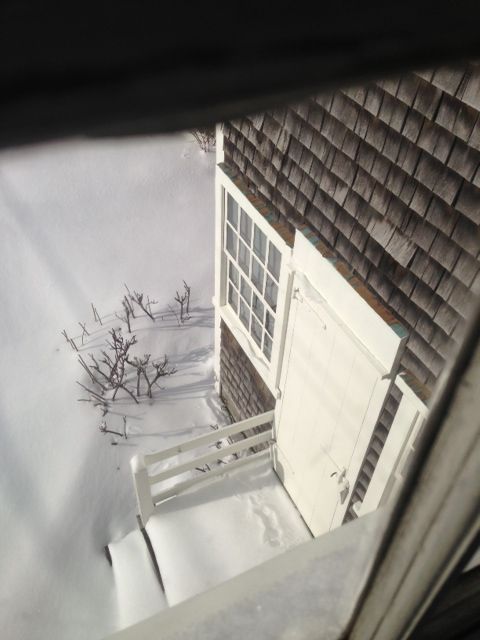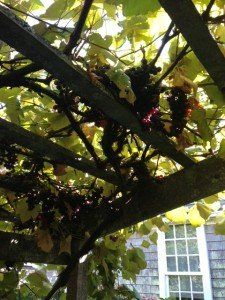The Grapes of Wrath?
At moments, I have a small choice word or two as I drag yet another squished grape into the cottage on the bottom of my foot. And then I think to myself, “It’s September at the Mitchell House!”
Peleg Mitchell Junior, Maria Mitchell’s uncle and the owner of 1 Vestal Street from 1836 until 1882 (his wife, Mary, continued to own the House until 1902 when she passed away) planted a grape arbor at the rear of Mitchell House. The grape plant continues to thrive to this day; in fact it is protected in the preservation easement on the Mitchell House. The original supports are long gone, but Peleg’s grapes continue on a new arbor. This year we have a bumper crop with no mold or any issues with the fruit it seems. Concord grapes, they start off sweet and then turn sour – an acquired taste. Some people like to eat the little tendrils that allow the grapes to climb, claiming they have a lemony flavor though I don’t taste that. The birds, in particular the catbirds, are made happy, especially with this year’s crop. When Peleg lived here they also had Isabella grapes climbing over the woodshed but unfortunately that structure and Neighbor North (the outhouse) are long gone.
In
Two Steps Down , Alice Albertson Shurrocks’s book about the Mitchell House, her grandfather was Peleg, she writes that the Concord grape arbor, “stood opposite to the cookroom at the edge of the sunny slope, leading from the upper grass plot to the lower . . . and I could look down on the vine from my bedroom.” She would spend her summers at 1 Vestal. The slope is long gone, replaced by a small retaining wall in the 1930s when the Curator’s Cottage was added at the rear of the House but it is still sunny.
Mrs. Shurrocks was married to Alfred Shurrocks, a well-respected architect who designed the Wing of the MMA Science Library. Mrs. Shurrocks was one of the curators of the MMA. They lived at 16 Vestal Street. In the next few weeks, I will give you an update on the conservation work there. The mason is just beginning!
JNLF
Recent Posts





